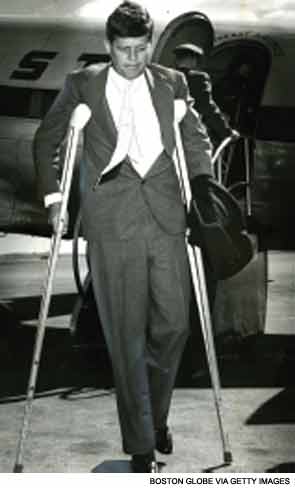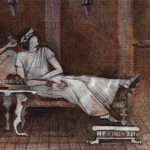
A Search for a Unifying Diagnosis
I was intrigued by previous reports about Kennedy’s medical history and the focus on his Addison’s disease, which was presumably due to an autoimmune pathogenesis. There may have been a genetic component as well, since his sister Eunice suffered from the same disorder. In addition, it has been suggested that Kennedy suffered from autoimmune polyendocrine syndrome type 2, defined by the coexistence of autoimmune adrenocortical insufficiency and evidence of adrenalitis, along with autoimmune thyroid disease.2 Yet, this endocrine diagnosis could not explain most of his medical issues. Thinking as a rheumatologist, it is hard to ignore some of the other aspects of the president’s story that lead one to consider the diagnosis of a spondylarthropathy.
The archives room at the JFK Library is a nondescript subterranean space littered with old photos and various props that are no longer displayed in the library exhibits. At one end of the room, technicians edit old television clips of JFK that will be shown at an upcoming panel discussion. The head archivist granted me full access to the president’s voluminous medical file. However, there were a few rules that I needed to follow: photographing or copying the file was prohibited, though I was allowed to take notes. Over the course of several visits, I had the opportunity to review the president’s medical and X-ray files. I learned some interesting aspects of his history that have not been well publicized.
Kennedy’s gastrointestinal illness began at age 13, when he developed abdominal pain, weight loss, and fatigue. When the pain intensified, his doctors decided to proceed with an appendectomy. This did not relieve his symptoms, which now included diffuse joint achiness and intense knee pains. There were more hospitalizations, including admissions to the Mayo Clinic and the Peter Bent Brigham Hospital in Boston. Abdominal pain remained a constant theme throughout his life and, despite the repeated barium enema studies and the recurring rectal probing via the rigid sigmoidoscope, no clear-cut diagnosis was ever established. Given the history of hematochezia and weight loss, the recurrent episodes of fever, weight loss, and anemia, the diagnosis of inflammatory bowel disease (IBD) needs to be seriously considered. Years later, it appears that one of the indications for treating Kennedy with corticosteroids, aside from his Addison’s disease, was his gastrointestinal illness. Thus, if one assumes that the diagnosis of IBD is correct, this raises the possibility that he also suffered from a spondylarthropathy. Let’s review the evidence. There is the remote history of transient monocular visual impairment as a child (uveitis?) and a history of recurrent episodes of urethritis. At first, his doctors concluded that these were likely sexually acquired, though over time, the diagnosis was subtly changed to “nonspecific” urethritis. I assume that his lack of a robust response to antibiotic therapy may have prompted this diagnostic reconsideration. There are several descriptions of intense knee pain, and I found a few knee X-rays taken during Kennedy’s adult years. They were fairly unremarkable in appearance. Specifically, I did not see any erosions or significant joint space narrowing, though none were taken in a weight-bearing stance.


